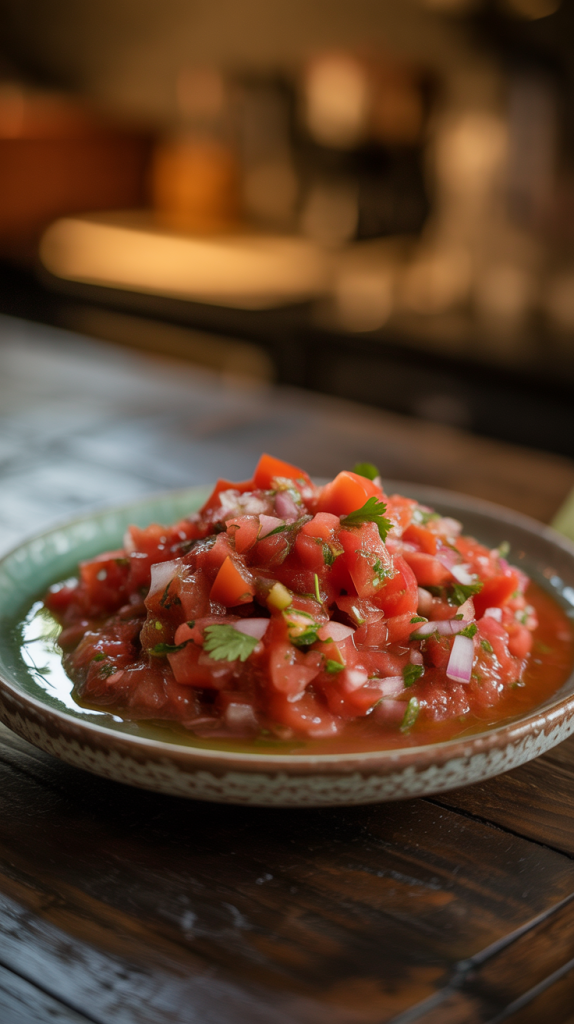The Ultimate Homemade Salsa Recipe: Fresh, Zesty & Irresistible

Homemade salsa is the heart of any vibrant kitchen—bursting with bold flavor, layered textures, and the satisfaction of scratch-made perfection. In this comprehensive guide, we unveil the most flavorful and customizable homemade salsa recipe using only fresh, high-quality ingredients.
Why Our Fresh Salsa Stands Out
What sets this salsa apart is the fine balance of acidity, sweetness, heat, and herbaceous freshness. It is designed to complement everything from tortilla chips to grilled meats, tacos, and even breakfast eggs.
Ingredients for Authentic Homemade Salsa
Here is what you’ll need to create the most irresistible salsa from scratch:
Base Ingredients
- 6 ripe Roma tomatoes, seeded and diced
- 1 large white onion, chopped
- 3 cloves garlic, minced
- 1–2 jalapeños, seeded for less heat or with seeds for spicier salsa
- 1 medium red bell pepper, finely diced (optional, adds sweetness and color)
- 1/4 cup fresh cilantro, chopped
- Juice of 1 lime
- Salt to taste (about 1 tsp)
- Freshly ground black pepper (½ tsp)
Optional Flavor Enhancers
- 1 teaspoon cumin – adds earthy depth
- 1 teaspoon sugar – balances acidity
- 1 small chipotle in adobo sauce – for a smoky kick
- 1 tablespoon apple cider vinegar – brightens flavor
Step-by-Step Instructions: How to Make Salsa from Scratch
1. Roast or Char for Rich Flavor
For added complexity, roast half of the tomatoes, garlic, and onion under a broiler or over an open flame until charred. Let cool and peel off any blackened skins.
2. Chop or Blend: Your Texture, Your Choice
Decide between chunky or smooth. For a chunky salsa, hand-chop all ingredients. For a smoother consistency, pulse in a food processor 3–5 times.
3. Combine and Balance
Mix all ingredients in a large bowl. Add lime juice, salt, and pepper. Taste and adjust seasoning, heat, and acidity. Let the salsa rest 30 minutes to allow flavors to meld.
Serving Suggestions for Every Occasion

- Classic Chips & Dip – Best served chilled with tortilla chips
- Breakfast Topping – Spoon over scrambled eggs, chilaquiles, or avocado toast
- Grilled Protein Companion – Works wonders with chicken, steak, or shrimp
- Taco Night Essential – Layered into tacos, burritos, or enchiladas
Fresh vs. Cooked Salsa: What’s the Difference?
| Aspect | Fresh Salsa (Pico de Gallo) | Cooked Salsa (Salsa Roja) |
|---|---|---|
| Texture | Crisp and chunky | Smooth and rich |
| Flavor Profile | Bright and herbaceous | Deep and smoky |
| Preparation Time | Short, no cooking needed | Requires simmering or roasting |
| Shelf Life | Best within 3 days | Can last up to a week refrigerated |
Storage Tips: Keep It Fresh
- Store in an airtight glass jar for up to 5 days in the refrigerator.
- For longer storage, freeze in portion-sized containers and thaw overnight.
- Always use a clean spoon to avoid contamination.
Make It Your Own: Variations You’ll Love
Mango Salsa
Add 1 diced ripe mango, remove cumin and bell pepper. Perfect for seafood or chicken.
Fire-Roasted Salsa
Roast all vegetables over open flame or grill. Blend for smoky, restaurant-style depth.
Avocado Salsa
Stir in 1 diced ripe avocado for a creamy texture, just before serving.
Green Salsa (Salsa Verde)
Use tomatillos instead of tomatoes, serrano peppers, and fresh mint for a tangy twist.
Nutritional Value (Per 1/4 Cup)
| Nutrient | Amount |
|---|---|
| Calories | 22 |
| Total Fat | 0g |
| Carbohydrates | 5g |
| Sugar | 2g |
| Fiber | 1g |
| Sodium | 170mg |
| Vitamin C | 18% DV |
How to Grow Your Own Salsa Garden
Plant These Key Ingredients:
graph TD
A[Tomatoes] --> Salsa
B[Jalapeños] --> Salsa
C[Cilantro] --> Salsa
D[Onions] --> Salsa
E[Garlic] --> Salsa
Salsa --> F[Homemade Garden Salsa]
- Tomatoes: Full sun, consistent watering
- Jalapeños: Thrive in heat, avoid overwatering
- Cilantro: Cool-weather herb, frequent harvest boosts yield
- Garlic and Onions: Plant in fall for summer harvest
FAQs About Homemade Salsa
Can I can this salsa for long-term storage?
Yes, but use a cooked version and follow USDA-approved canning procedures.
How spicy is this recipe?
Mild to medium. For more heat, use serrano or habanero peppers.
Can I use canned tomatoes?
Yes, but use fire-roasted or San Marzano tomatoes for better flavor.
What kind of blender works best?
A high-power blender or food processor gives the smoothest result; a hand blender works for smaller batches.
Conclusion: A Salsa That Steals the Show
This salsa isn’t just a dip—it’s a fresh, flavor-packed centerpiece that elevates any meal. Whether served as a simple snack or part of a full-on Mexican feast, this recipe adapts to your tastes, dietary needs, and creativity. Make it once, and it’s sure to become a staple in your kitchen.